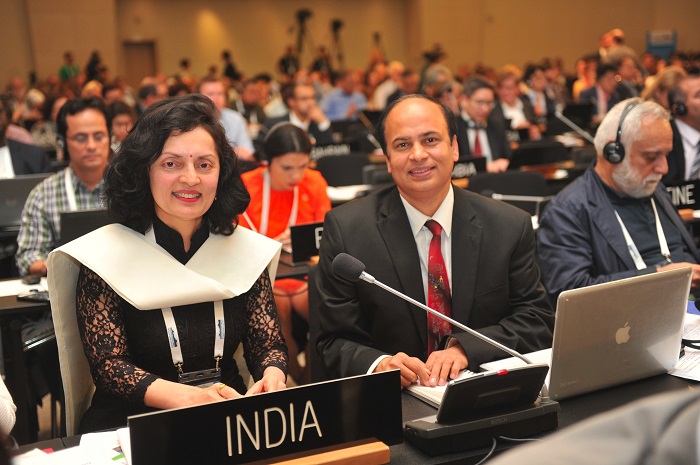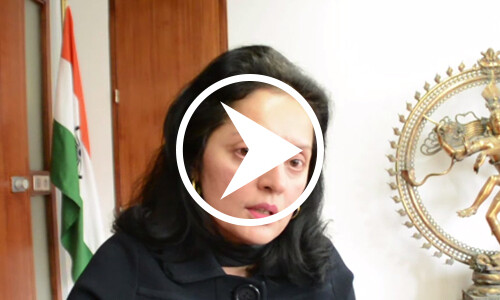Nalanda University in Bihar

Permanent representative of India to UNESCO, Ruchira Kamboj at the 40th session of the World Heritage Committee in Istanbul
In the 40th edition of World Heritage Session in Istanbul, from July 10-20, India celebrates its 34th UNESCO (United Nations Educational, Scientific and Cultural Organisation) world heritage site with the inscription of Archaeological Site of Nalanda Mahavihara (Nalanda University) at Nalanda in Bihar.
After a lull moment at the UNESCO world heritage session last year, India came back to the game with the inscription of one of the oldest universities in Southeast Asia this year. On day five of the World Heritage Session, held from July 10-20, in Istanbul, Turkey, the committee met yesterday to inscribe four new sites including the ruins of Nalanda University in the Bihar state of India dating back to the third century BC. Other monuments include ‘The Persian Qanat’ of Iran, ‘Nan Madol’ – ceremonial centre of Eastern Micronesia – and ‘Zuojiang Huashan Rock Art Cultural Landscape’ of China. The Nalanda site, located nearly 100 kilometres from the capital of Bihar, Patna, comprise of the archaeological remains of a monastic and scholastic institution from third century BC to 13th century AD. This includes stupas, shrines, viharas (residential and educational buildings) and artworks in stucco, stone and metal.
“Nalanda stands out as the most ancient university of the Indian Subcontinent and engaged in the organised transmission of knowledge over an uninterrupted period of 800 years The historical development of the site testifies to the development of Buddhism into a religion and the flourishing of monastic and educational traditions,” said UNESCO on its website,” says UNESCO website. With this there would be second UNESCO world heritage site in Bihar after Mahabodhi, a Buddhist temple, in Bodhgaya, inscribed in 2002.
Just inscribed as @UNESCO #WorldHeritage Site: Archaeological Site of Nalanda Mahavihara at Nalanda, Bihar #India pic.twitter.com/R7FH3D5MM2
— UNESCO (@UNESCO) July 15, 2016
Before the inscription
The Nalanda archaeological site first got included in the Tentative List of World Heritage in January 2009. Allegedly, there was a doubt surrounding its inscription from UNESCO as there were several flaws in the dossier prepared by the Archaeological Survey of India (ASI). ASI, incidentally, first began the excavation of the site that had been abandoned since its destruction. ASI records suggest that subjects taught at Nalanda included theology, grammar, logic, astronomy, metaphysics, medicine and philosophy. There are references that the ancient Nalanda city was spread over an area of 16 square kilometres, of which only an area of around 1 square kilometre is excavated.
The ASI had sent a 200-page dossier to UNESCO last January following which an expert team from Paris based International Council of Monuments and Sites (ICOMOS) led by Japanese expert Masaya Masui visited the site for inspection. The agency recommended deferring the title to Nalanda Mahavihara. It also recommended the project label to be changed from “Excavated Remains” to “Archaeological Remains” of Nalanda Mahavihara. Sources suggest that Chanchal Kumar, secretary to Bihar chief minister, also visited Paris last month to persuade the World Heritage Centre of UNESCO.
“The proposal for the Nalanda ruins was initially rejected as the report raised questions over its status as a university and its outstanding universal value. Questions were raised whether Nalanda was a university or a monastery. However, the permanent representative of India to UNESCO, Ruchira Kamboj, and director (conservation) at ASI went to Istanbul to present our case,” general secretary, BR Mani, Indian Archaeological Society told the media.
Prime Minister Narendra Modi and several other union ministers took to social media to express their happiness. While PM Modi retweeted the UNESCO tweet, chief minister Nitish Kumar on Facebook credited the success to the joint Centre-state effort.












